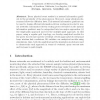Free Online Productivity Tools
i2Speak
i2Symbol
i2OCR
iTex2Img
iWeb2Print
iWeb2Shot
i2Type
iPdf2Split
iPdf2Merge
i2Bopomofo
i2Arabic
i2Style
i2Image
i2PDF
iLatex2Rtf
Sci2ools
DCOSS
2005
Springer
2005
Springer
Analysis of Gradient-Based Routing Protocols in Sensor Networks
Abstract. Every physical event results in a natural information gradient in the proximity of the phenomenon. Moreover, many physical phenomena follow the diffusion laws. This natural information gradient can be used to design efficient information-driven routing protocols for sensor networks. Information-driven routing protocols based on the natural information gradient, may be categorized into two major approaches: (i) the single-path approach and (ii) the multiple-path approach. In this paper, using a regular grid topology, we develop analytical models for the query success rate and the overhead of both approaches for ideal and lossy wireless link conditions. We validate our analytical models using simulations. Also, both the analytical and the simulation models are used to characterize each approach in terms of overhead, query success rate and increase in path length.
DCOSS 2005 | Information-driven Routing Protocols | Natural Information Gradient | Query Success Rate |
Related Content
| Added | 26 Jun 2010 |
| Updated | 26 Jun 2010 |
| Type | Conference |
| Year | 2005 |
| Where | DCOSS |
| Authors | Jabed Faruque, Konstantinos Psounis, Ahmed Helmy |
Comments (0)

